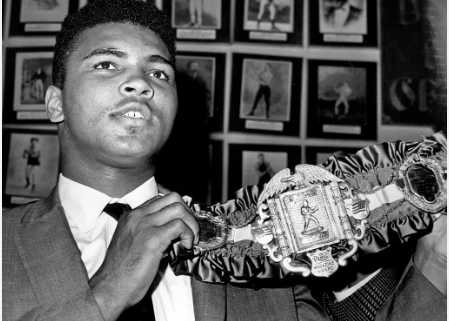“Float like a butterfly, sting like a bee.”
People who read sports quotes for motivation definitely know the above one, therefore, Muhammad Ali. The American boxer is considered to be one of the greatest boxers of all time. However, the real question lies in whether he is the greatest of them all.
In any sport, picking one name as the GOAT (Greatest of All Time) is usually tricky. Comparing different eras is never straight-forward due to varying quality of opponents, advancements in science and nutrition, and rule changes.
Nevertheless, a few names always seem to be doing the rounds and Ali’s is one among them. Born Cassius Marcellus Clay Jr., it is impossible to look at his career alone when his life was intertwined strongly with what happened in the ring.
Ali kicked off his incredible achievements list with an Olympic gold in 1960 at the age of 18. After turning pro in the same year, it did not take long for the Kentucky native to rise to the top. He beat Sonny Liston in 1964 and became the youngest boxer to win the title from a reigning heavyweight champion at the age of 22.

His conviction was finally overturned in 1971 and he went on to win the heavyweight championship two more times against Joe Frazier and George Freeman.
This made him the only boxer to become a three-time lineal champion (beating an undisputed champion to become the champion) in the sport, a record he holds even to the current day. The fact that he won it thrice despite not fighting in his peak years (25-29) gives further weight to his achievement.
Multiple accolades accompanied his achievements with reputed publications such as Sports Illustrated and BBC among them.
Normally, heavyweight boxers are associated more with immense punching power as one would expect from the weight class. This includes legends in the GOAT discussion such as Joe Louis and Rocky Marciano. However, Ali was unique to possess quick feet and reflexes, constantly moving around the ring, especially in the early part of his career.
Later, Ali adapted his style in the 1970s as he lost his quick movement and took in more punishment. However, he perfected the ‘rope-a-dope’ technique to great effect. Ali used to lean on the ropes, cushioning his opponent punches until they get tired. He then used to go ahead and finish them off.
This highlighted his ability to absorb punishment to a great extent when needed before dishing some of his now.
Further, Ali used to trash-talk his opponents in the ring, taunting and tempting them to retaliate. He used to take the opening and land multiple punches of his own, frustrating his opponents further.
No wonder, his bouts even have names such as “The Rumble in the Jungle” against Freeman and “Thrilla in Manila” against Frazier.
Several movies, biographies and pop-culture representation place Ali head and shoulders above his fellow boxers. His impact on the boxing world and beyond was immense for several reasons.
His success inside the ring, unique fighting style and pre-match antics definitely played a huge part. On the other hand, his vocal fight for his rights, along with the coloured community’s struck a chord across the United States and beyond.
Parkinson’s disease dramatically reduced his public appearances in the last two decades of his life. However, one is more likely to find an Ali quote or poster or painting in gyms and homes across the world, a sure-shot sign of his eternal legacy.
Thus, Ali makes more than a strong case for being the greatest heavyweight boxer of all time. While debates continue, his dominance in arguably the best boxing era and his enduring legacy puts him above his brethren.
After all, when someone is nicknamed “The Greatest”, he might as well be.
This website uses cookies.